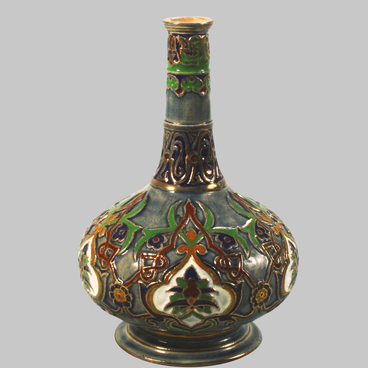The works of ceramists of the Imperial Stroganov Central School of Industrial Art presented in this part of the exhibition are united by a common theme. The items are dedicated to the images of the inhabitants of pre-Petrine Rus and interpret the traditional Russian costume.
The school was founded by Count Sergei Stroganov in 1825 in Moscow. Originally it was the ‘School of Drawing in Relation to Arts and Crafts’. Stroganov himself was a representative of the famous family of the richest industrialists, a participant in the Patriotic War of 1812, an advocate of education, a trustee of the Moscow Educational District, who actively advocated the development of national art.
‘The purpose of this institution is to give youngsters (from 10 to 16 years old), who devote themselves to all sorts of crafts and crafts, the opportunity to acquire the art of drawing, without which no artisan is able to give his products the possible perfection, ” — wrote Stroganov. Education and meals for most of the students were free, the school accepted children of commoners and serfs.
The series “Peoples of Russia”, created at the Imperial Porcelain Factory at the end of the 18th century, in which the costumes of residents of Russian regions and representatives of various professions were made with documentary precision, is widely known. The genre sculpture of the Stroganov workshop, by contrast, was distinguished by its decorativeness.
“The Scribe” sculpture, presented in the exhibition, depicts the “sovereign”s man” at the time of his announcement of the royal decree. The porcelain figure was entrusted to paint a third-grade student Sophia Brandenburg, and this student’s work turned out to be one of the few signed sculptures of the ceramic and porcelain workshops of the Stroganov School.
Another famous and most replicated sculpture of the school’s ceramic workshop is the “Woman in Russian folk costume”. It entered the history of Russian ceramics under a shorter name — “Baba” (“Village Woman”). Stroganov’s ‘women’ are found in the collections of many museums: they are all alike, but at the same time somehow differ from one another. All works are based on one model — a generalized image of a Russian woman in a folk costume, which consists of a shirt, a sarafan, a sleeveless jacket and a kokoshnik. At the same time, each has its own facial expression, head tilt, the painting of sarafans and kokoshniks is different. The authorship of this sculpture is attributed to the head of the ceramic workshop Nikolai Andreev, but this assumption has not been documented.
The school was founded by Count Sergei Stroganov in 1825 in Moscow. Originally it was the ‘School of Drawing in Relation to Arts and Crafts’. Stroganov himself was a representative of the famous family of the richest industrialists, a participant in the Patriotic War of 1812, an advocate of education, a trustee of the Moscow Educational District, who actively advocated the development of national art.
‘The purpose of this institution is to give youngsters (from 10 to 16 years old), who devote themselves to all sorts of crafts and crafts, the opportunity to acquire the art of drawing, without which no artisan is able to give his products the possible perfection, ” — wrote Stroganov. Education and meals for most of the students were free, the school accepted children of commoners and serfs.
The series “Peoples of Russia”, created at the Imperial Porcelain Factory at the end of the 18th century, in which the costumes of residents of Russian regions and representatives of various professions were made with documentary precision, is widely known. The genre sculpture of the Stroganov workshop, by contrast, was distinguished by its decorativeness.
“The Scribe” sculpture, presented in the exhibition, depicts the “sovereign”s man” at the time of his announcement of the royal decree. The porcelain figure was entrusted to paint a third-grade student Sophia Brandenburg, and this student’s work turned out to be one of the few signed sculptures of the ceramic and porcelain workshops of the Stroganov School.
Another famous and most replicated sculpture of the school’s ceramic workshop is the “Woman in Russian folk costume”. It entered the history of Russian ceramics under a shorter name — “Baba” (“Village Woman”). Stroganov’s ‘women’ are found in the collections of many museums: they are all alike, but at the same time somehow differ from one another. All works are based on one model — a generalized image of a Russian woman in a folk costume, which consists of a shirt, a sarafan, a sleeveless jacket and a kokoshnik. At the same time, each has its own facial expression, head tilt, the painting of sarafans and kokoshniks is different. The authorship of this sculpture is attributed to the head of the ceramic workshop Nikolai Andreev, but this assumption has not been documented.



